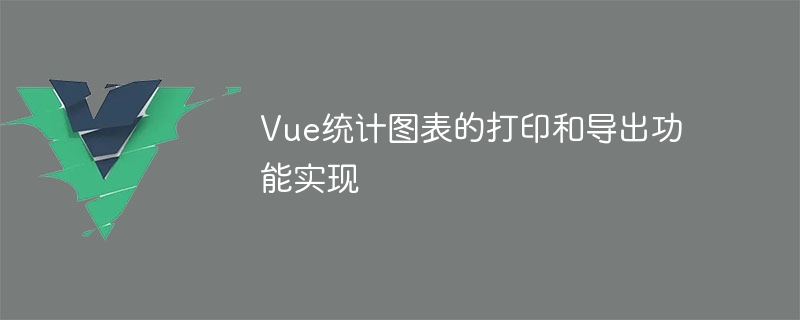

Vue.js is a popular JavaScript framework for building user interfaces. In Vue, we can use various third-party libraries to implement various functions. This article will introduce how to implement the printing and exporting functions of statistical charts in Vue.
1. Introducing third-party libraries
In order to realize the printing and exporting functions of statistical charts, we need to introduce two third-party libraries: html2canvas and file-saver. html2canvas is used to convert the chart area into a picture, and file-saver is used to save the picture as a file.
First, install these two libraries in the Vue project:
npm install html2canvas file-saver --save
Then, in the components that need to use the printing and export functions, introduce and use these two libraries:
import html2canvas from 'html2canvas';
import { saveAs } from 'file-saver';2. Implement the printing function
To implement the printing function, we need to convert the chart area into a picture and display the picture in a new window. The user can then print out the image using the browser's print function.
In the Vue component, we can use the following code to implement the printing function:
methods: {
printChart() {
const chartContainer = document.getElementById('chart-container');
html2canvas(chartContainer).then((canvas) => {
const chartImage = canvas.toDataURL('image/png');
const windowContent = '<!DOCTYPE html>';
const printWindow = window.open('', '', 'width=600,height=800');
printWindow.document.write(windowContent);
printWindow.document.write('<html><head><title>打印图表</title></head><body>');
printWindow.document.write(`<img src="/static/imghw/default1.png" data-src="${chartImage}" class="lazy" style="max-width:90%" alt="Implementation of printing and exporting functions of Vue statistical charts" >`);
printWindow.document.write('</body></html>');
setTimeout(() => {
printWindow.print();
}, 500);
});
}
}In the above code, we first use html2canvas to convert the chart container into a picture. Then, create a new window and display the image in it. Finally, use the print() method to trigger the browser's printing function.
3. Implement the export function
To implement the export function, we need to convert the chart area into a picture and save the picture as a file.
In the Vue component, we can use the following code to implement the export function:
methods: {
exportChart() {
const chartContainer = document.getElementById('chart-container');
html2canvas(chartContainer).then((canvas) => {
canvas.toBlob((blob) => {
saveAs(blob, 'chart.png');
});
});
}
}In the above code, we use html2canvas to convert the chart container into a picture, and convert the picture into a Blob object. Then, use file-saver's saveAs() method to save the Blob object to a file. The file name is chart.png and can be modified according to the actual situation.
4. Use the function in the template
Finally, add a button to the template and click the button to trigger the print and export functions:
<template>
<div>
<div id="chart-container">
<!-- 统计图表的代码 -->
</div>
<button @click="printChart">打印</button>
<button @click="exportChart">导出</button>
</div>
</template>In the above code, click Print button to trigger the printChart method, and click the Export button to trigger the exportChart method.
Through the above code examples, we can implement the printing and exporting functions of statistical charts in Vue. In this way, users can easily print out or export charts to files for further analysis and sharing.
The above is the detailed content of Implementation of printing and exporting functions of Vue statistical charts. For more information, please follow other related articles on the PHP Chinese website!